Characteristically, the ‘agricultural tribe’ (nōrin zoku) of the ruling Liberal Democratic Party (LDP) had an input into the spending plan for the farming sector. The TPP has provided the Abe administration with an opportunity to restore higher levels of funding to agricultural public works — one of the Ministry of Agriculture, Forestry and Fisheries (MAFF) and LDP’s favourite spending grounds.
Three of the major expenditure categories announced in the package entail spending on agricultural public works. These are ‘developing bearer-farmers with good business acumen’, ‘promoting internationally competitive production regions’ and ‘reinforcing the earning capacities of livestock and dairy farmers’. They amount in total to over 94 billion yen (US$780 million), or just over 30 per cent of the total 312.2 billion yen (US$2.6 billion) allocated to TPP-related measures.
Despite the high-blown policy rhetoric used to describe the purpose of the spending, it amounts, by and large, to more money for earth and irrigation works on farms. The three categories of expenditure simply represent various kinds of land improvement projects (tochi kairyō jigyōhi), which have traditionally involved maintaining agricultural infrastructure such as farmland and waterways. Such projects have been a focus of politicised expenditure for decades and are now described as necessary to ‘reinforce the structure of agriculture’.
‘Developing bearer-farmers with good business acumen’, at a cost of 37 billion yen (US$307 million) will focus on expanding the scale of plots of farmland (daikukakuka), which the MAFF argued would improve agricultural productivity and competitiveness. But this is hardly a recipe for expanding the scale of farming, which is what is really needed to make Japan’s agricultural sector more competitive, including bringing abandoned farmland into production.
Similarly, the spending on ‘promoting internationally competitive production regions’ (40.6 billion yen or US$337 million) is for converting paddy fields to dry fields as well as for developing dry fields and orchards, while ‘reinforcing the earning capacities of livestock and dairy farmers’ will involve maintaining and expanding plots of grassland in so-called livestock ‘clusters’ in order to increase farmers’ income. This will attract 16.4 billion yen, or US$136 million in spending.
In a throwback to the bad old days of direct intervention by LDP farm politicians in policymaking, the nōrin zoku have been pressing for an increase in the land improvement budget in preparation for the upper house election in mid 2016. They also pushed for a bigger total allocation for the agriculture, forestry and fisheries supplementary budget. When the MAFF presented its draft proposal for 387.1 billion yen (US$ 3.2 billion), many politicians, including the nōrin zoku, demanded more funds and refused to approve the MAFF draft.
One Diet member attending the LDP’s agriculture, forestry and fisheries meeting emphasised, ‘A budget for TPP-related measures that does not exceed 300 yen billion [US$2.5 billion] won’t convey the right impression’. Nōrin zoku executive and chairman of the LDP’s Research Commission on Agriculture, Forestry and Fisheries Strategy Kōya Nishikawa told MAFF executives before the meeting concluded, ‘It feels like it’s not quite enough for the first year of the TPP-related measures. We want the total amount of the budget to be more than 400 billion yen [US$3.3 billion]’. This is despite his earlier comment on NHK News that ‘We will not blindly use the budget this time for TPP-related subsidies.’ The fruit of LDP pressure was an additional 13.7 billion yen (US$113.7 million), reminiscent of the ‘political additions’ to government spending proposals achieved by LDP farm politicians over the decades.
The nōrin zoku were especially keen to restore funding for land improvement after the previous Democratic Party of Japan (DPJ) government of 2009–2012 cut the outlay by more than 60 per cent in their first budget. This was part of former DPJ Secretary-General Ichirō Ozawa’s plan to punish land improvement organisations for their close links to the LDP. But, after the LDP was restored to power at the end of 2012, locals and LDP agricultural politicians began to press for a revival of this spending.
Another important political factor contributing to the content of the TPP-related measures is direct representation of the land improvement industry within government. The LDP’s General Council Chairman, Toshihiro Nikai, happens to be the chairman of the National Federation of Land Improvement Associations. He made a direct request to expand the expenditure on land improvement saying, ‘We will form a budget that will make it clear that power has returned to the LDP’.
All this is despite the widespread belief that the Abe government would not repeat the mistakes of the past, such as the misdirection of the large, ‘subsidy scattering’ (baramaki) budget allocated to agriculture after the Uruguay Round Agreement in 1994. At that time, more than half of the 6 trillion yen (US$49.8 billion) in expenditure was allocated to agriculture and rural areas development projects. But much of it was wasted on the construction of useless roads and other facilities, such as hot springs, which had no relationship to reinforcing the competitiveness of agriculture at all.
According to some commentators the current spending plans look like ‘the Uruguay Round measures all over again’. And, as former MAFF official Kazuhito Yamashita points out, ‘Just like the Uruguay Round-related measures, the TPP-related measures will be implemented even though there will be no impact [on agriculture]’.
Aurelia George Mulgan is a Professor at the University of New South Wales, Canberra.


So PM Abe is continuing the LDP’s tradition of securing votes from rural Japan with these expenditures in their domains?
The article fails to note that rural Japan is over represented in the Diet. Ie, there are more Diet members per population in these rural areas than there are in the metropolitan parts of the country. Thus, in order to remain in power the LDP has always made sure to provide them with these kinds of juicy programs.
Electoral malapportionment in Japan is so widely known that it goes without saying.